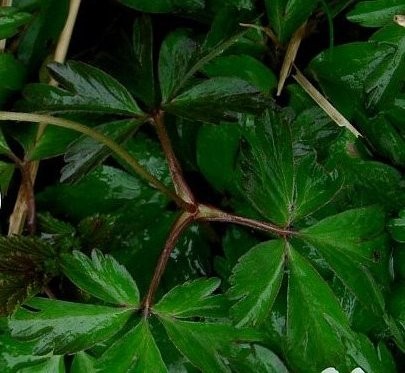Three-leaved anemone
(Anemone reflexa)

Description
Anemonoides trifolia (syn. Anemone trifolia), the three-leaved anemone, is a perennial herbaceous plant in buttercup family (Ranunculaceae). The plant has stems growing 10–30 cm tall and bear single, white (rarely pale pink or pale bluish) flowers two centimetres in diameter, with five to nine (most often six) elliptical tepals. The fruit is a cluster of 2 mm achenes. Its leaves are divided into three lanceolate leaflets and form a single whorl of three leaves per stem; the leaflets have a toothed but not lobed margin. The rhizome, found directly below surface is whitish, and tends to form dense clonal colonies. In subsp. albida, the achenes are pendulous. The flowering period extends from April through June. The species differs from Anemonoides nemorosa in its white or pale blue anthers (unlike the yellow anthers of A. nemorosa) and simple lanceolate leaflets lacking the deep lobing of A. nemorosa. Anemonoides trifolia is very similar to Anemonoides nemorosa, but has a more restricted range in southern and central Europe, from Portugal and Spain east to Hungary, and locally north to Finland, where one small population occurs. It occurs in hardwood forests and rocky sites up to 1860 metres altitude. Anemone is a genus of flowering plants in the buttercup family Ranunculaceae. Plants of the genus are commonly called windflowers. They are native to the temperate and subtropical regions of all continents except Australia, New Zealand and Antarctica. The genus is closely related to several other genera including Anemonoides, Anemonastrum, Hepatica, and Pulsatilla. Some botanists include these genera within Anemone. Anemone are perennials that have basal leaves with long leaf-stems that can be upright or prostrate. Leaves are simple or compound with lobed, parted, or undivided leaf blades. The leaf margins are toothed or entire. Flowers with 4–27 sepals are produced singly, in cymes of 2–9 flowers, or in umbels, above a cluster of leaf- or sepal-like bracts. Sepals may be any color. The pistils have one ovule. The flowers have nectaries, but petals are missing in the majority of species. The fruits are ovoid to obovoid shaped achenes that are collected together in a tight cluster, ending variously lengthened stalks; though many species have sessile clusters terminating the stems. The achenes are beaked and some species have feathery hairs attached to them.
Taxonomic tree:







